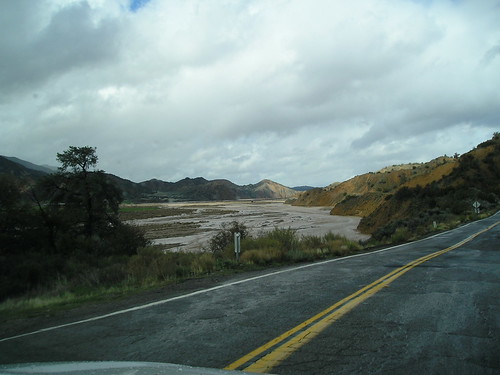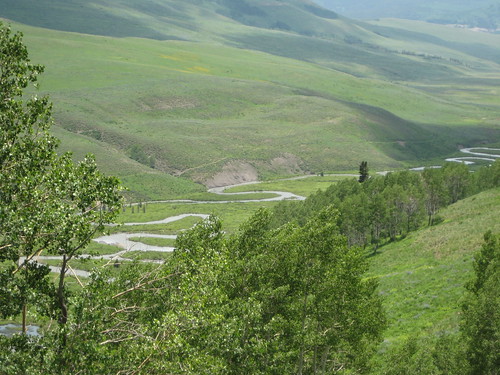Last week I wrote a post speculating about possible effects of autumn leaves on the flow of rivers and streams. I noticed that the leaves were forming small dams in slow water and decreasing flow rate, but that during a flood, the leaves would quickly be washed away. Since that time, I have come across some new research on much more profound effects that trees and other plants have on rivers. Recent evidence suggests that plants offer much more than just a minor role in affecting river flow. In fact, when plants like ferns, trees, and grasses colonized the land many millions of years ago, they changed the very nature of how rivers flow.
When rivers are in an open area and not bound by topography, they often take on one of two forms.
Braided rivers, like the one above (the Cuyama River in California, seen during a rare period of high water), tend to form in areas where there are very large amounts of sediment, such as usually-dry washes that contain heavy sediment loads during flash floods (the Cuyama River is almost always dry in the above section), and rivers flowing out of glaciers. Braided rivers are also sometimes seen downstream from highly degraded watersheds. Usually there is not dense vegetation along these rivers, and one might surmise that this is due to the unstable nature of the river, but as described in the link above the photo, the opposite may be true, at least in part.
Braided rivers are always changing, laying down and replacing sediment, and wandering over their flood plain. They are not good rivers to live near, and are extremely difficult to control.
Meandering rivers, like the East River near Crested Butte, Colorado, seen above, generally stick to one channel, but that channel wanders widely. As described in this previous blog post, erosion happens on the outside of the bends, and sediment is deposited on the inside of the bends, until a bend cuts back upon itself, the river jumps to its new path, and the process begins again.
Recent evidence shows that before land plants were abundant, most rivers were braided. Now, most meander.
People working to simulate river processes with stream tables have noted that it is very difficult to create a miniature meandering river - stream tables usually result in braided streams. While some of this has to do with the size and weight of particles in the stream table, it largely has to do with the fact that areas of sediment deposition are not stabilized by plants. One group of researchers realized this and were finally able to simulate a meandering river - by using alfalfa sprouts to stabilize the stream table soil!
The take-home message? The relationship between a river and its riparian vegetation is not a one-way relationship. These plant species are specifically adapted to conditions along rivers and streams, and often only occur in these areas. However, rivers as we know them today can only exist with this vegetation intact. Without vegetation, many rivers would take over their entire flood plain, replacing farm fields and bottomland forest with a complex of shifting, braided channels. They would flood more often and more severely, and dry up more readily during drier periods. There is often the temptation to remove vegetation along rivers to reduce 'flood risk' and get rid of vegetation that is 'clogging' the river. But, with the exception of a few invasive plants, this is not actually the case. By removing riparian vegetation we are not only aesthetically impairing the river, but also creating many more problems for ourselves.
So, next time you are near a meandering river, find a cottonwood tree to hug, and thank it for helping to create a slow-flowing, rich, clean, beautiful waterway.



No comments:
Post a Comment